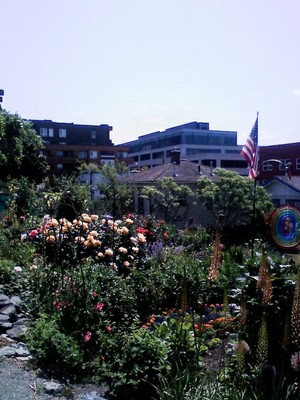 Spring has sprung and for thousands of northwesterners, thumbs are turning green. But for apartment or condo dwellers—like me—urban gardening can be a challenge. Many new buildings are being outfitted with rooftop gardens for tenants’ use, but they’re still spendy and scarce; most of us will have to look to home-owning friends with a few square feet to spare or vie with neighbors for a plot in high-demand community gardens.
Spring has sprung and for thousands of northwesterners, thumbs are turning green. But for apartment or condo dwellers—like me—urban gardening can be a challenge. Many new buildings are being outfitted with rooftop gardens for tenants’ use, but they’re still spendy and scarce; most of us will have to look to home-owning friends with a few square feet to spare or vie with neighbors for a plot in high-demand community gardens.
How does a community garden work? Typically, the city or program (some are run by private developers) sets aside a patch of land—portions of parks, undeveloped lots, etc—ranging anywhere from 2,000-200,000 sq. ft. in size. The land is parceled into individual plots ranging from under 100 sq. ft. to over 400. Individuals pay under $100/year for a plot. Each location may have different specific requirements, but they generally make sure gardeners are actually using the plot.
I’ve heard a lot of hype in the last couple of years, and wondering where the vegetable starts on my windowsill will be planted next month got me thinking more about community gardens in the Northwest: How common are they? And how competitive can they really be?
 Just a quick perusal of city gardening sites confirmed what I’d heard through the grapevine—there are far more green thumbs than available plots, leaving some waiting for as many as five years.
Just a quick perusal of city gardening sites confirmed what I’d heard through the grapevine—there are far more green thumbs than available plots, leaving some waiting for as many as five years.
Here’s a quick run-down of where the Northwest’s three major metropolises stand on community gardens:
- Vancouver, BC (4.3 plots per 1,000 people): The Community Gardens program has expanded greatly in the last four years—from 950 plots to 2,500 across 50 gardens. The city also has a great program helping to match garden-owners with neighbors looking for an empty patch of soil.
- Portland, Oregon (5.2 plots per 1,000 people): The city’s Community Gardens program hosts 32 gardens, used by about 3,000 gardeners (with another 1,000 on the waiting list). Additionally, the city sponsors programs to connect urban gardeners with surplus food with families in need, and to teach youth about gardening and food production.
- Seattle, WA (6.3 plots per 1,000 people): Heralded as one of the US’s best urban gardening programs, the P-Patch program has more than 70 gardens over 23 acres—used by 3,800 urban gardeners with another 2,000 on waitlists (which take anywhere from three months to five years). Over half of the gardeners are low income, and the program donates 7-10 tons of fresh produce each year through Solid Ground’s Lettuce Link program.
Yet despite all the positive press and demand, I have to question the ability of p-patches to make a large impact on our food systems. A dedicated community garden owner on 200 square feet might produce a substantial portion of their vegetables (see end note), but a hobbyist on 90 square feet may simply contribute some tasty additions to their spring and summer suppers. And with an average of only 5 plots per 1,000 residents of the biggest Northwest cities, the programs have a long way to go before they are a major part of our food system or a solution to poor nutrition.
Instead, I think of community gardens along the same lines as food carts—maybe the measurable benefits aren’t so great, but they have an important place in a vibrant urban culture: they often fill land that would otherwise go unused; provide green spaces in some of our cities’ densest neighborhoods; contribute a significant chunk of fresh, healthy produce for those who otherwise might lack access; give kids hands-on experience to understand where food comes from and how ecosystems work; and, as I mentioned before, add a certain je ne sais quoi to dense, urban living by providing non-homeowners with one of the more fun advantages of having a yard.
 Perhaps most importantly, there’s an enhanced sense of community when a group of neighbors get together and dig into the earth. Certainly the Victory Gardens of both World Wars provided a morale booster to civilians who felt like they were contributing to war effort (if Wikipedia is to be trusted—and it probably isn’t—they contributed 40 percent of the US’s vegetable consumption). Maybe community gardens provide a similar morale boost for those engaged in the slow-motion sustainability revolution.
Perhaps most importantly, there’s an enhanced sense of community when a group of neighbors get together and dig into the earth. Certainly the Victory Gardens of both World Wars provided a morale booster to civilians who felt like they were contributing to war effort (if Wikipedia is to be trusted—and it probably isn’t—they contributed 40 percent of the US’s vegetable consumption). Maybe community gardens provide a similar morale boost for those engaged in the slow-motion sustainability revolution.
Unfortunately, with a waiting time of at least a year, it doesn’t look like a p-patch will be the answer for my veggies this year. But it’s good to see such enthusiasm for public green spaces. I’m curious to hear if any of our readers have a community garden plot—and if so, what you think about it?
*End note: A quick search suggests gardens yield about 0.6 lbs of vegetables per square foot per season, and Americans consume 428 lbs of vegetables per capita per year, on average.
For Seattle-area readers, this week Darrin Nordahl, author of Public Produce: The New Urban Agriculture will be speaking in Seattle at IslandWood on 4/28, and Town Hall on 4/29.
Seedlings image courtesy of Jackal of All Trades and Gardeners picture courtesy of sbcg08 via Flickr under the Creative Commons License. P-Patch picture is of the Belltown p-patch, taken by me.








Elaine
Eric, you might want to check out this book by UW prof Jeffrey Hou and friends: “Greening Cities, Growing Communities: Learning from Seattle’s Urban Community Gardens.”
Eric Hess
Thanks, Elaine. Looks like a good one!
Jessica
For Seattleites who are on that P-Patch waiting list, a good alternative is Urban Garden Share: http://www.urbangardenshare.org/—they list homeowners who have gardens they won’t be planting in and then pair them up with gardeners in need nearby. Then both share the harvest. A fantastic solution!
Eric Hess
Thanks, Jess. I had overlooked that resource, but Lisa caught it in her post The Dirt on Urban Ag
paul hughes
CG’s are a distraction in terms of real food security, but you cannot beat them for recruiting and education, 2 of the 3 pillars of a local food system. (Capacity is the 3rd)
Journeyman Matt
Eric,I’ve often wished there were more p-patch spaces available like you I have been astounded by the wait period. I have a yard that is mostly in the shade of our neighbors’ 40 foot wall o’ laurel, so it’s best suited to moss production. We have sun in the parking strip, but even in affluent Greenlake/Latona, people have stolen the pumpkins my wife has grown in the front. That’s also why I’ve never actively pursued the spaces next to the freeway wall in our neighborhood, even though every time I pass those unused swaths of ground I think what great use they could be put to as community gardens. We make do in little nooks, but part of the fun of it for me would be gardening WITH others, in community. I’ve also tried to imagine a design for a residential rooftop system that wouldn’t damage shingles or torchdowns, but a big part of gardening for me is teaching my daughter (5) and I’m not keen to have her fall 25 feet onto the patio while watering the broccoli. What to do? Thanks for this article. Matt
Eric Hess
Paul Hughes—You’re right. The community benefits outweigh the practical benefits for the total food system.Journeyman Matt—It’s a tough conundrum. Maybe there’s a neighbor near you with a sunny yard who has room to share? http://www.urbangardenshare.org/
Skye Schell
Great piece. Don’t forget about Tacoma and Olympia – great work in both cities. In Tacoma, Cascade Land Conservancy & a number of great local partners recently held a community garden summit and the mayor announced the city is creating 7 new community gardens. Sign up here if you want to join one of the new gardens.Skye